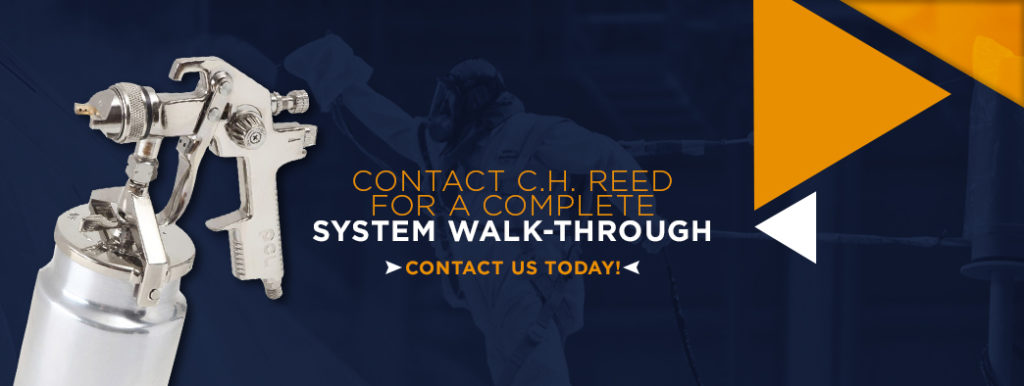June 6, 2019
How to Increase Transfer Efficiency in Your Paint Finishing Process
SHARE THIS POST
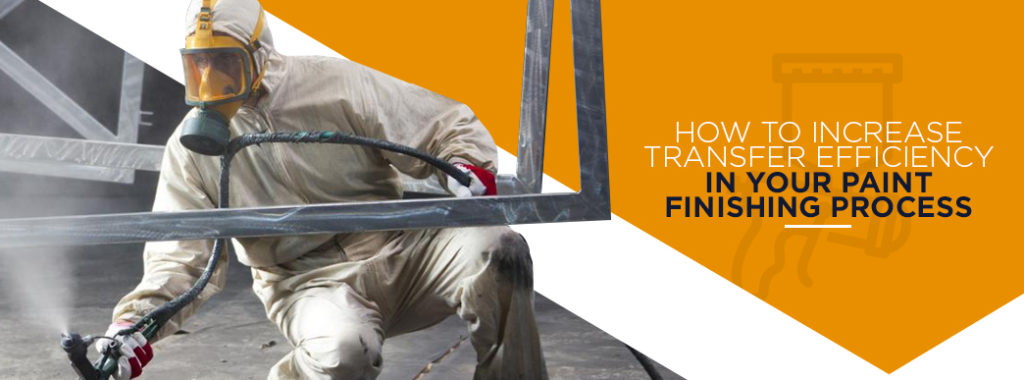
Finishing operations throughout America constantly strive to improve efficiency in their paint and coating processes. As the industrial finishing market increases in competition, leading operations prudently look for better methods to decrease material consumption, promote higher environmental values and control harmful exposures to their workforce. One of the best ways to achieve all three goals is by increasing transfer efficiency in your paint finishing process.
The North American paint and coating market is huge. According to a recent Mordor Intelligence report, this market intelligence and analysis firm anticipates the finishing industry’s compound annual growth rate (CAGR) will increase by 4.16 percent for 2019-2024. That covers all end-user protective coating sectors including the automotive, architectural, electronic, industrial, packaging and transportation industries.
As in all markets, paint and coating businesses search for meaningful methods to reduce operating costs and grow profitability. Responsible managers drill down in their process functions to identify critical areas where they can prosper by making efficient operational changes. If you’re involved in the paint and coating business, you may be wondering how to improve your powder coating or painting operations. It all has to do with transfer efficiency.
Table of Contents
What Is Paint Transfer Efficiency?
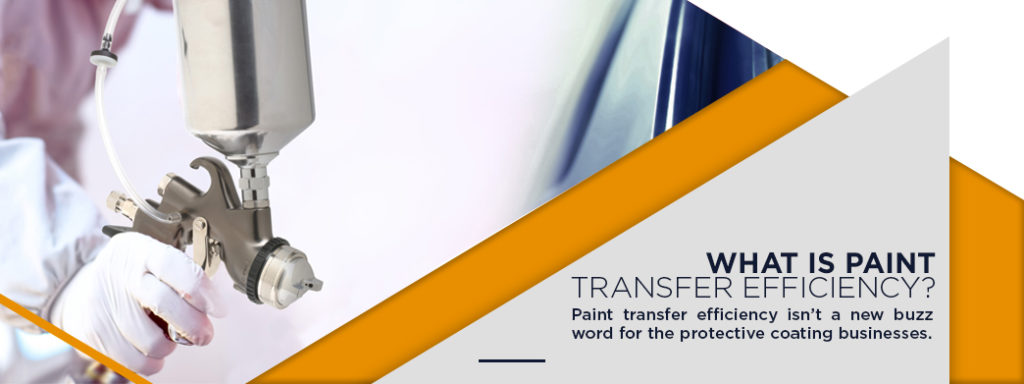
Paint transfer efficiency isn’t a new buzzword for the protective coating businesses. It’s a well-recognized industry term that describes a critical aspect of spray paint and powder coating processes. Quite simply, paint transfer efficiency refers to how much coating sticks to a finished product compared to how much product is wasted through slippage like overspray, excessive coating and misdirection.
The official paint transfer efficiency definition comes from the American Society for Testing and Materials (ASTM) and their directive D5009 Standard Test Method for Evaluating and Comparing Transfer Efficiency of Spray Applied Coatings Under Laboratory Conditions. The ASTM describes paint transfer efficiency as a ratio of paint solids (by weight) deposited on a product in relation to the total amount of solids sprayed.
There’s another industry-recognized paint transfer efficiency formula. This comes from the Ohio Environmental Protection Agency (OEPA) and refers to transfer efficiency (TE) as a percentage, rather than a ratio. The OEPA calculates TE by dividing the original amount of paint solids (by volume) sprayed by the number of solids adhering to the painted object.
Whether you calculate paint transfer efficiency by the weight method or the volume method, the variance in the figures gives you an idea of how efficient or inefficient your coating process really is. If you have a volume TE calculation of 80 percent and an equal TE weight calculation of 4:5, your transfer efficiency is fairly decent by industry standards. However, there’s always room to improve transfer efficiency.
How to Increase Transfer Efficiency
Improving the transfer efficiency of paint starts with understanding your process and equipment capabilities. This includes knowing your paint application workers and how they’re performing with your current model. After all, it’s your technicians and applicators that will really make a difference in increasing your spray gun transfer efficiency and your powder coating transfer efficiency.
It’s worth revisiting weight and volume transfer efficiency calculations. If you have an 80-percent efficiency in transferring paint through spray or powder coat applications, that means you’re wasting or inefficient with 20 percent of your solid coating materials. By looking at this as a ratio, it means you’re leaving one out of every five paint parts on the table.
This inefficiency adds up to a lot of money slippage that could be recovered by increasing your transfer efficiency. Fortunately, there are some distinct steps you can take to tighten your coating processes and transfer that savings to your bottom line.
The first thing to examine is what type of coating application process and equipment you’re currently using. Making a change to more efficient tools can have a huge return. Here is a look at what applicators are available on the American coating equipment market and how they rate in transfer efficiency:
- Conventional spray painting: This is the least efficient process for transferring paint from a container to a finished part or object. Conventional spray equipment is inexpensive, but you get what you pay for. The lack of precision spray control due to high pressure results in significant overspray and poor efficiency.
- High volume low pressure (HVLP): This application process is similar to conventional spray painting but a notch up in efficiency. Because the pressure is lower, it applies higher coating volumes with less overspray and waste. The disadvantage to HVLP application is its inability to cover tight places and irregular shapes.
- Airless sprayers: These mid-efficiency applicators replace air with fluid pressure. Hydraulics allow for high compression that atomizes paint and allows heavier weights to be sprayed per volume compared to air sprayers. Airless applicators do a better job of evenly covering difficult parts but tend to overcoat and compromise transfer efficiency.
- Air assist sprayers: You can get a good compromise with higher efficiency by combining air and fluid pressure. Air assist sprayers introduce compressed air into the spray through a nozzle or air cap. The fluid pressure with an air boost allows excellent coverage with reduced loss through overspray or over-coating.
- Electrostatic application: One of the most efficient paint transfer processes is electrostatic application. This system uses electrically charged paint particles to attract to an alternately charged part surface. Powder coating has minimal overspray and superbly uniform coating results.
- Rotary atomizing bell: At the top of the paint transfer efficiency scale is a rotational atomizing bell. This application method involves a spinning metal disc flinging energized paint particles towards a grounded surface. Rotary atomizing bell processes are exceptionally efficient in maximizing paint solids by weight and volume. The only drawback is the equipment investment cost.
No matter what finish application system or process you use, it won’t function at peak efficiency unless your workforce is correctly trained and competent to operate it. Training is equally important to increasing paint transfer efficiency as having the right equipment. Proper operation techniques can greatly increase your transfer efficiency.
Increasing transfer efficiency training has enormous paybacks. In fact, the benefits from training are so significant that it’s worth investing in professional help for paint finishing supervision and maintenance training services. These are the points that paint transfer efficiency training should cover:
- Distance: The physical distance between the applicator tip and the coating surface is critical for peak transfer efficiency. This measurement varies depending on the equipment type, the coating material and what surface it’s being applied to. There is no rule-of-thumb with distance, and it depends on individual characteristics as well as product experience.
- Angle: The application angle highly affects paint transfer efficiency. The most efficient application angle is usually directly perpendicular between the nozzle and the work surface. However, there are exceptions to this rule, and a knowledgeable trainer will help your workers find the sweet-spot angle for a particular process.
- Trigger: Mastering precise trigger control is crucial for transfer efficiency. Depressing a trigger too early in an application pass causes unnecessary overspray and wasted paint material. Triggers depressed too late result in insufficient coating and a necessity to reapply. Both too-early and too-late triggering are inefficiencies but can easily be overcome with training and practice.
- Technique: Paint application techniques are similar to handwriting. Each of your applicators will develop or have their own style. To increase paint transfer efficiency, workers must master techniques of activation, overlap, crosshatch and stroke speed as well as learning to decrease leading and trailing edges.
Professional supervision and training will also help your paint and coating applicators to know their equipment. Painters and coaters greatly improve transfer efficiency when they know their tools and feel comfortable with them. One of the first efficiency steps to master is knowing the proper spray gun setup.
Proper Spray Gun Setup
It’s paramount that your spray gun is set up properly if you want to achieve maximum paint transfer efficiency in every paint and coating operation. Setting up a spray gun isn’t difficult as long as you and your applicators know the individual brand of equipment’s peculiarities and the manufacturer’s instructions. You also have to know your paint materials as well as the product you’re finishing.
The main concern in setting up spray equipment is having the correct gun pressure. That includes both air and fluid pressure depending on your equipment design. Too much pressure results in paint bouncing off the product being finished and wasted material. Pressures set too low won’t allow correct paint delivery, which also causes waste.
The second important setup point is having the correct nozzle for the specific gun. It’s also critical that the spray nozzle is precisely adjusted for the paint type and desired finish. Any wrong adjustment will cause overspray or over-coating that reduces transfer efficiency. These are the common spray gun nozzles:
- Full cone: This is the most common spray head which produces an even and circular-shaped pattern.
- Hollow cone: This is a modified version of the full cone except it produces a ring-shaped pattern.
- Flat stream: This nozzle produces a fan-shaped or brush-stroke application pattern.
Powder coat application guns also require proper setup to achieve the best possible paint transfer efficiency. Electrostatic guns also produce various patterns, and it’s critical to set up the gun for the specific application job. The most important issue with setting up powder coating guns is selecting the right voltage and having the work correctly grounded.
Size and Shape of the Part Being Painted
Differently shaped parts require different application techniques and settings. Large and evenly-shaped parts can be easier to finish than small irregular surfaces. Parts with tight crevices and multiple angles can be tricky to finish and still maintain high transfer efficiency.
It’s critical to select the right application tool for the product being finished. The biggest cause of paint waste and transfer inefficiency with challenging parts is overspray. Matching the right setup for the part is crucial to prevent excessive spray or over-coating.
Gun pressure also has to be compatible with the part’s size and shape. Making the right match is a matter of painter experience and individual technique. The more time your applicator has with specific parts, the more efficient they’ll become with paint transfer.
Painter Technique
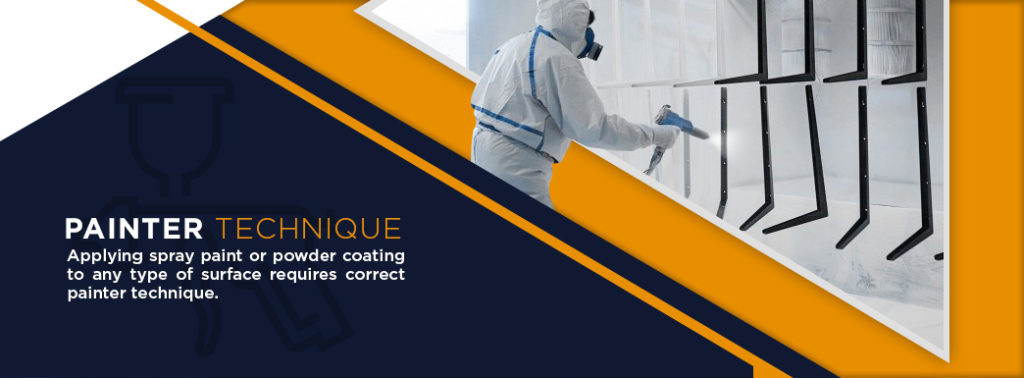
Applying spray paint or powder coating to any type of surface requires the correct painter technique. This isn’t something that comes naturally for most applicators. Technique is a learned skill and fine-tunes with practice.
Excellent painter technique is a blend of choosing the right paint mixture, correctly setting up the gun with the right nozzle and knowing the finished product’s properties. Skilled painting technique involves precise gun triggering as well as maintaining the optimum distance between the nozzle tip and surface. Advanced techniques include precise application angles, stroke patterns and minimizing leading and trailing edge overspray.
Painting technique is a skill that’s relatively easy to teach. It’s far more efficient to spend the time and resources properly training a paint applicator than having them struggle to learn techniques by trial and error. This is where a third-party paint finishing supervision and training service provider can instruct your applicators to develop skills and improve their transfer efficiency.
Paint Gun Applicator Selection and Proper Equipment
Selecting the proper paint gun applicator and related equipment is also another vital part of improving paint transfer efficiency. A third-party service provider like C.H. Reed can deliver more than training and maintenance. C.H. Reed will also help you select the right paint gun and related equipment for all your paint and coating work.
C.H. Reed supplies mix room equipment, pneumatic pumps and electric pumps that help you improve efficiency in all types of paint transfer applications. We help you compare processes like hand-mixing, hot-potting and using an electronic proportioner. Here are other services you can benefit from when you select C.H. Reed to improve your paint transfer efficiency:
- Scheduled services, repair and maintenance for paint finishing and process equipment
- Pumps, paint guns and application tools and accessories services and repair
- Spray booths, ovens and integrated systems services
- Plural component metering equipment services
- Paint finishing supervision and maintenance training services
Benefits of Facility Assessment and Paint Finishing Analysis From C.H. Reed
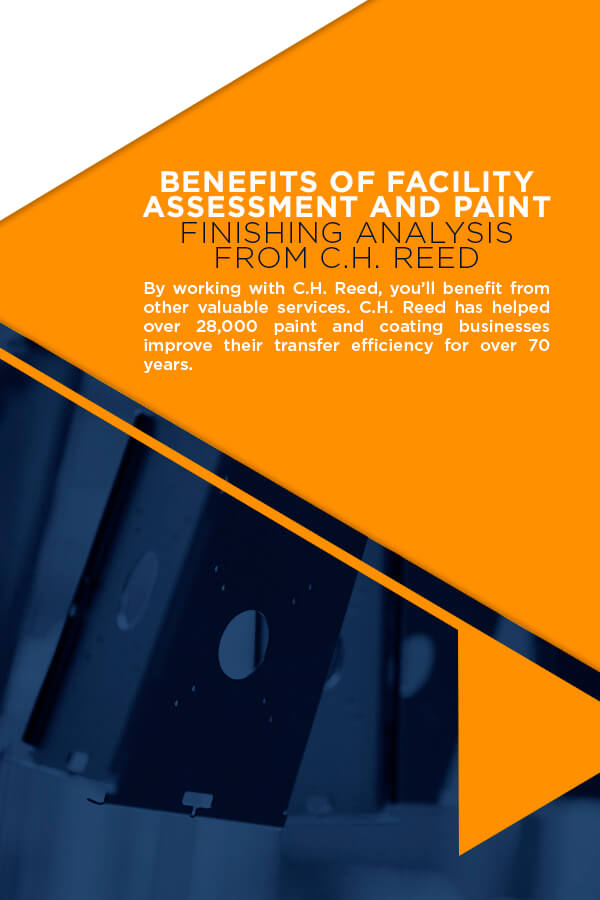
By working with C.H. Reed, you’ll benefit from other valuable services. C.H. Reed has helped thousands of manufacturers improve their transfer efficiency of paint over the years. Our benefits and services include:
- Complete system designs
- Paint and powder systems analysis
- Engineering and automation services
- Environmental, ergonomic and energy analysis
- Systems diagnosis and troubleshooting
- Supervision and training programs
- Routine process inspections
- Complete system walk-throughs
Contact C.H. Reed for a Complete System Walk-Through
C.H. Reed will help you get the most from your finishing processes and improve your paint transfer efficiency. If you feel you’re not running at peak painting efficiency and don’t know why, contact C.H. Reed to request a complete system walk-through. Our experts will help you identify process shortfalls and recommend solutions to bring your transfer efficiency up where it should be.
With a sales and service footprint covering the entire mid-Atlantic region, we can help you meet your facility’s paint finishing, protective coatings, fluid transfer, and compressed air goals from one of our centralized branch locations:
- Hanover, PA
- Milton, PA
- Erie, PA
- Pittsburgh, PA
- Cleveland, OH
- & throughout VA, WV, MD, DE, & NY
Whether you require equipment updates, applicator training or a thorough maintenance program, C.H. Reed will help you integrate the best systems and solutions for your strategic application. Call C.H. Reed today at 800-692-7216 and schedule a comprehensive walk-through at your facility. You can also reach us through our online contact form.
Updated July 2023
Search
Categories
Get a consultation
Related Posts
The 3 Distinct Advantages of Hydraulic Powered Pumps
Recently, C. H. Reed helped a major printing operation install a new ink pumping system. The new system needed to transfer four colors of high viscosity, heat-set ink to their three presses, drawing the ink from multiple 5,000…
Simple Ways to Reduce Waste in Your Spray Finishing System
In today’s demanding manufacturing landscape, it can be convenient to adopt a “cut-costs-at-all-costs” mentality, justifying questionable means for the sake of leaner production, a lower bottom line and increased profitability. Regrettably, those efforts can interfere…
What You Need to Know About Air-Powered Pressure Washers
Pressure washers are great solutions for your average cleaning applications, but what tool do you turn to for your more challenging applications? There are many instances where it is simply impossible to use a traditional…
